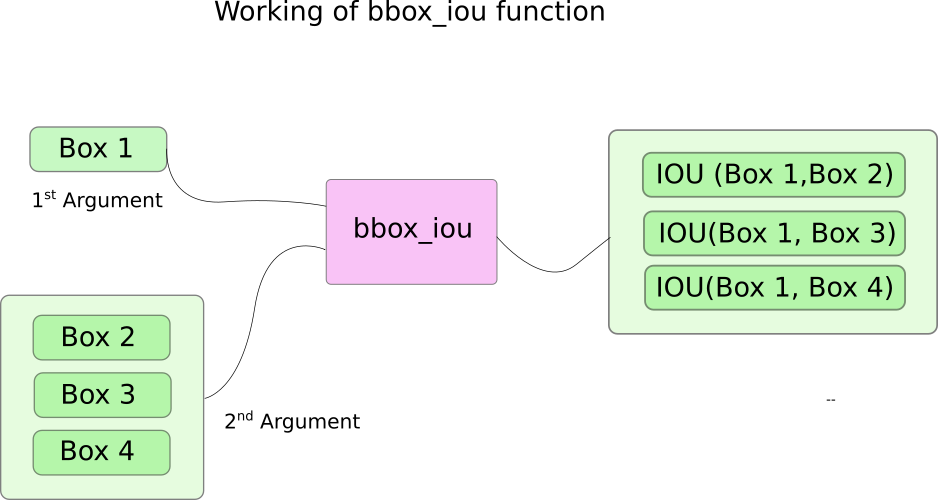前一节我们实现了网络的前向传播。这一节我们对检测输出设置目标置信度阈值和进行非极大值抑制。
必要条件:
1.此系列教程的Part1到Part3。
2.Pytorch的基本知识,包括如何使用nn.Module,nn.Sequential,torch.nn.parameter类构建常规的结构
3.numpy的基础知识
此前我们已经建立了一个模型,给定一张输入图片它能产生B*10674*85维的输出向量。B是批中图片的数目,10674是每张图片预测的边界框数目,85是边界框属性数目。
但就像我们在part1中描述的那样,我们必须对输出进行目标置信度阈值化和非极大值抑制,以获得最终剩余的真正检测。为此,我们将在文件util.py中创建一个名为write_results的函数。
def write_results(prediction, confidence, num_classes, nms_conf = 0.4):
这个函数将prediction、confidence(目标置信度阈值)、num_classes(在我们的示例中是80)和nms_conf (NMS IoU的阈值)作为输入。
目标置信度阈值:
我们的预测张量包含了关于B x 10647个边界框的信息。对于每个目标置信度低于阈值的边界框,我们将它的每个属性(行向量)的值设置为零。
conf_mask = (prediction[:,:,4] > confidence).float().unsqueeze(2)
prediction = prediction*conf_mask
执行极大值抑制:
我们现在拥有的是边界框的中心坐标以及高度和宽度,然而使用边界框的对角点更容易计算IOU。因此,我们将框的(center x, center y, height, width)属性转换为(左上角x,左上角y,右下角x,右下角y)。
box_corner = prediction.new(prediction.shape) box_corner[:,:,0] = (prediction[:,:,0] - prediction[:,:,2]/2) box_corner[:,:,1] = (prediction[:,:,1] - prediction[:,:,3]/2) box_corner[:,:,2] = (prediction[:,:,0] + prediction[:,:,2]/2) box_corner[:,:,3] = (prediction[:,:,1] + prediction[:,:,3]/2) prediction[:,:,:4] = box_corner[:,:,:4]
每幅图像中真实检测框的数目可能不同。例如,一批大小为3的图像,其中图像1、2和3分别有5、2、4个真检测值。因此,每次必须对同一个图像进行置信阈值和NMS,而不能对所涉及的操作进行矢量化,必须在预测的第一个维度(包含成批图像的索引)上进行遍历操作。
batch_size = prediction.size(0) write = False for ind in range(batch_size): image_pred = prediction[ind] #image Tensor #confidence threshholding #NMS
write标志位用于指示我们是否对output进行了初始化,将会使用一个向量来收集整个批中真实的预测。
循环的开始我们进行数据清理。因为每个边界框行有85个属性,其中80个是类得分。我们只关心类得分最大值的那个,所以会从每行中删除80个类得分,添加具有最大值的类的索引,以及该类的类得分。
max_conf, max_conf_score = torch.max(image_pred[:,5:5+ num_classes], 1) max_conf = max_conf.float().unsqueeze(1) max_conf_score = max_conf_score.float().unsqueeze(1) seq = (image_pred[:,:5], max_conf, max_conf_score)
image_pred = torch.cat(seq, 1)
我们前面已经将目标置信度得分低于阈值的边界框行属性设置为了0,现在就筛除它们。
non_zero_ind = (torch.nonzero(image_pred[:,4])) try: image_pred_ = image_pred[non_zero_ind.squeeze(),:].view(-1,7)
except: continue #For PyTorch 0.4 compatibility #Since the above code with not raise exception for no detection #as scalars are supported in PyTorch 0.4 if image_pred_.shape[0] == 0: continue
try-except块用于处理没有检测到的情况。在这种情况下,我们使用continue跳过此图像的其余循环体。
接下来,让我们在图像中检测目标。
#Get the various classes detected in the image img_classes = unique(image_pred_[:,-1]) # -1 index holds the class index
因为对于同一个类别可能存在多个正确检测,我们使用一个叫unique的函数来获得给定图片中所有出现的类。
def unique(tensor): tensor_np = tensor.cpu().numpy() unique_np = np.unique(tensor_np) unique_tensor = torch.from_numpy(unique_np) tensor_res = tensor.new(unique_tensor.shape) tensor_res.copy_(unique_tensor) return tensor_res
之后我们对于每个类进行NMS
for cls in img_classes: #perform NMS
一进入这个循环,首先要做的事情就是提取对于某一特定类别的检测(用变量cls表示)
#get the detections with one particular class cls_mask = image_pred_*(image_pred_[:,-1] == cls).float().unsqueeze(1) class_mask_ind = torch.nonzero(cls_mask[:,-2]).squeeze() image_pred_class = image_pred_[class_mask_ind].view(-1,7) #sort the detections such that the entry with the maximum objectness #confidence is at the top conf_sort_index = torch.sort(image_pred_class[:,4], descending = True )[1] image_pred_class = image_pred_class[conf_sort_index] idx = image_pred_class.size(0) #Number of detections
然后我们进行NMS
for i in range(idx): #Get the IOUs of all boxes that come after the one we are looking at #in the loop try: ious = bbox_iou(image_pred_class[i].unsqueeze(0), image_pred_class[i+1:]) except ValueError: break except IndexError: break #Zero out all the detections that have IoU > treshhold iou_mask = (ious < nms_conf).float().unsqueeze(1) image_pred_class[i+1:] *= iou_mask #Remove the non-zero entries non_zero_ind = torch.nonzero(image_pred_class[:,4]).squeeze() image_pred_class = image_pred_class[non_zero_ind].view(-1,7)
这里我们使用到了一个函数bbox_iou。第一个输入参数是循环体变量i索引处的边界框,第二个输入参数是多行边界框的一个tensor。函数bbox_iou的输出是一个tensor它包含了第一个输入的边界框与第二个输入的所有边界框的IOU。如下:

之前我们已经将目标置信度高的边界框放在前面,如果后面的边界框IoU值与前面的相比超过了阈值,那后者就会被删去。
循环体里面下面这行计算IoU。
ious = bbox_iou(image_pred_class[i].unsqueeze(0), image_pred_class[i+1:])
每轮迭代,如果有任何索引大于i的边界框与第i个边界框的IoU大于阈值nms_thresh,那这个边界框就会被删除。
#Zero out all the detections that have IoU > treshhold iou_mask = (ious < nms_conf).float().unsqueeze(1) image_pred_class[i+1:] *= iou_mask #Remove the non-zero entries non_zero_ind = torch.nonzero(image_pred_class[:,4]).squeeze() image_pred_class = image_pred_class[non_zero_ind]
还要注意的是,我们将计算IoU的代码行放在try-catch块中。这是因为此循环按照id进行迭代(image_pred_class中的行数)。但因为我们循环过程中可能会从image_pred_class中删除一些边界框。这样一来,迭代可能会出现索引越界触发IndexError或者image_pred_class[i+1:]返回一个空张量触发ValueError。此时我们可以确定NMS已经无法删除多余的边界框了,从而跳出循环。
计算IoU:
def bbox_iou(box1, box2): """ Returns the IoU of two bounding boxes """ #Get the coordinates of bounding boxes b1_x1, b1_y1, b1_x2, b1_y2 = box1[:,0], box1[:,1], box1[:,2], box1[:,3] b2_x1, b2_y1, b2_x2, b2_y2 = box2[:,0], box2[:,1], box2[:,2], box2[:,3] #get the corrdinates of the intersection rectangle inter_rect_x1 = torch.max(b1_x1, b2_x1) inter_rect_y1 = torch.max(b1_y1, b2_y1) inter_rect_x2 = torch.min(b1_x2, b2_x2) inter_rect_y2 = torch.min(b1_y2, b2_y2) #Intersection area inter_area = torch.clamp(inter_rect_x2 - inter_rect_x1 + 1, min=0) * torch.clamp(inter_rect_y2 - inter_rect_y1 + 1, min=0) #Union Area b1_area = (b1_x2 - b1_x1 + 1)*(b1_y2 - b1_y1 + 1) b2_area = (b2_x2 - b2_x1 + 1)*(b2_y2 - b2_y1 + 1) iou = inter_area / (b1_area + b2_area - inter_area) return iou
写入预测:
write_results函数输出一个形状为 Dx8 的tensor。这里D是所有图像的真实检测,每个都用一行表示。每个检测有8个属性,即检测所属批次图像的索引、4个角坐标、目标置信度得分、最大置信类得分、该类的索引。
和此前一样,我们等到有一个检测时才初始化输出向量并将后续的检测拼接进来。使用写标志来表示tensor是否已经初始化。在遍历类的循环结束时,我们将检测结果添加到输出tensor中。
batch_ind = image_pred_class.new(image_pred_class.size(0), 1).fill_(ind) #Repeat the batch_id for as many detections of the class cls in the image seq = batch_ind, image_pred_class if not write: output = torch.cat(seq,1) write = True
else: out = torch.cat(seq,1) output = torch.cat((output,out))
在函数的末尾,我们检查输出是否已经初始化。如果没有,就意味着这批图像中没有一个检测到。在这种情况下,我们返回0。
try: return output except: return 0
这就是这一部分所要讲解的内容了。现在我们终于有了一个预测,它以tensor的形式列出了每一个边界框。所以只剩下一件事就是创建一个输入管道来从磁盘读取图像,计算预测,在图像上绘制边界框,然后显示/写入这些图像。这是我们下一部分要做的。